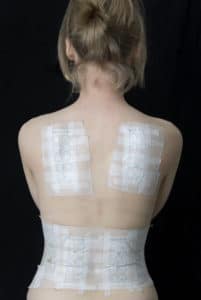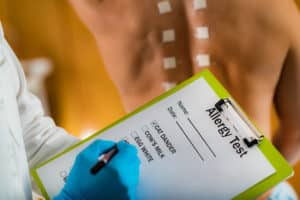
WHAT IS PATCH TESTING?
Patch testing is a convenient and predictable method of diagnosing allergic contact dermatitis. It involves applying patches to a person’s back or neck. Each patch contains a suspected irritant (allergen) in a small disc or chamber. The chemical or substance on the patch is detected by the skin’s immune system. The skin either reacts with irritation, a positive result, or does not.
HOW DO I PREPARE FOR A PATCH TEST?
- Preparation for a patch test begins two weeks before your appointment. At that time, we request that you avoid sun exposure.
- Starting one week before your appointment, you should avoid using topical medicines on your back or other areas on which patches may be placed. If you are unsure about potential patch locations, contact our office. Products may continue to be used in areas of the body which will not be patched.
- You may use skin moisturizers until the day before your appointment.
HOW DOES PATCH TESTING WORK?
Patches are applied to the back or other convenient area, where they must remain for 2 days. The pads or panels must not be removed during this time. After 2 days, panels are removed in the office, where the doctor observes the skin and takes note of signs of an allergic reaction. After another 2 to 5 days, a second examination is done. This helps to identify which reactions are irritant and which are allergic if any. Signs of an allergic reaction include redness, tiny blisters, or a small rash with swelling.
CAN YOU SHOWER AFTER A PATCH TEST?
It is important NOT to get the panels or surrounding skin wet. During the time when patches are on the skin, it is best to sponge-bathe. After the patches have been removed, it is still important NOT to get the area wet. You may shower but only if you can avoid water reaching the back or other skin where patches had been applied.
In addition to avoiding showers during the patch test process, you should avoid exercise or other activities that may cause you to sweat. If a panel becomes loose, the hypoallergenic tape may be placed around the edges to reattach it.

WHAT DOES A POSITIVE PATCH TEST LOOK LIKE?
The skin’s immune system recognizes irritants and allergens relatively quickly, which is why the first reading occurs after just 2 days of wear. However, it can take up to 10 days for a full response to be evident. A positive allergen may look like a small rash with red, raised skin. Tiny blisters may also be visible.
If your patch test reveals allergens, your doctor will discuss the substance or substances that are involved, including where you may come into contact with them in your day-to-day life. They may have information regarding the types of products that may contain the substances causing your allergic reaction, assisting you in beginning to develop a list of alternatives or strategies for avoidance.
IS PATCH TESTING UNCOMFORTABLE?
No. Patch testing contains precise amounts of suspected irritants and allergens. This minimizes the risk of a strong, uncomfortable allergic reaction. The skin’s response to patch testing is typically only strong enough to help your doctor discern between irritation and allergic contact dermatitis.
WHAT ARE THE SIDE EFFECTS OF PATCH TESTING?
The most common side effects reported are mild burning and itching sensations. It is important to avoid scratching the test area. This could exacerbate the irritation and may also affect the doctor’s ability to accurately read your skin’s response. Rarely do itching and burning become severe. If this happens, contact the doctor immediately.
WHAT CHEMICALS ARE TESTED IN A PATCH TEST?
Patch tests may include a wide variety of different suspected allergens. Examples include topical medications, cosmetics, hair dye, and other substances that a patient may come into contact with.

Sometimes, patients provide their own sample of one or more suspected irritants. Generally, doctors use the North American Contact Dermatitis Group (NACDG) Standard Screening Tray, which includes approximately 80 different chemicals. These range from a fragrance mix to Bacitracin. Before your test, your doctor will discuss the specific types of substances that are included in your process.
SCHEDULE A CONSULTATION
The Skin and Beauty Center proudly serves areas in and around Glendale, Burbank, Pasadena, Northridge, Santa Clarita, and West Hills. Contact an office near you to learn more about patch testing for allergic contact dermatitis.
